(Well, you can bake pizza without these items, but they’ve made my pizza-baking efforts easier and have improved the end product immeasurably.)
Why You Need a Stone and a Peel
The two items I now consider to be essential are a pizza stone and a pizza peel, which really work in tandem. For many years I used my pizza stone without a pizza peel and I have to tell you that using the pizza peel makes all the difference in the world.
To get a nicely browned crust on the bottom of your pizza, it’s best to place the dough directly onto a hot pizza stone. However, if you’re rolling the dough out directly onto the stone, it’s impossible to preheat it, and if you have preheated the stone, it’s tough to transfer the dough to the hot stone.
Enter the pizza peel, which makes the dough transfer a piece of cake (or pizza, I suppose).
Here’s my basic pizza-making routine. I preheat the stone in the oven for 15-20 minutes, to make sure it’s very hot. I then roll out my pizza dough on a lightly floured surface. I sprinkle a bit of flour onto the pizza peel, and then lift the rolled-out dough onto the peel. Since there’s a thin coat of flour on the dough and peel, the dough doesn’t stick, and so to transfer it to the hot stone, all I have to do is open the oven door, lower the peel to the level of the baking stone, and give the peel a sort of flicking motion with my arm to make the dough slide off onto the stone.
When I’m making thin-crust pizza, I put both the tomato sauce and cheese on top of the dough before sliding it into the oven, but when I’m making a pizza with a more middle-of-the-road crust, I top it with a thin layer of tomato sauce, bake it for five minutes, and then take it out to add more toppings before I finish baking it.
I also use my pizza stone when I bake deep-dish pizza (the cake pans sit on top of the stone) and when I make stromboli and calzones.
Buying a Pizza Stone and Peel
Though I think it’s often wise to invest in good kitchenware even if it’s expensive, I’m pleased to report that a pizza stone and pizza peel will not require a fistful of cash. The pizza stone and peel that I have were only $15 at Bed, Bath, and Beyond (I don’t see it on their website, but last I checked it was still available in store). Honestly, I can’t tell even the slightest difference between this stone and the Pampered Chef stone that I used to have, so I would advise against buying a really expensive stone.
Taking Care of Your Stone and Peel
When you first get your stone, it will be slightly bumpy and fairly light in color. As you use it, the surface will become smoother and darker, and will turn into a more non-stick sort of surface. Here’s what mine looks like.
Since pizza stones are porous, it’s best not to use soap on them, as they could absorb a soapy smell and flavor. I just rinse mine with water after it’s cooled off, and if something like cheese has melted on, I use a plastic spatula to scrape it off. My stone is so smooth by now, though, hardly anything sticks to it. It’s not pretty…
…but it’s thoroughly seasoned, and it works far better now than it did when it was all new and pristine.
Pizza stones are sensitive to sudden temperature changes and can break if you are not careful. When heating a stone, make sure to put it in the cold oven and let it preheat along with the oven. When your stone is hot, let it cool off completely before washing it off, to avoid giving it a cold shock.
I’ve been using my pizza peel (the one that came in the $15 set) for quite a number of years, and there’s no sign of it wearing out, save for a small crack which doesn’t affect its performance at all.
Since it hardly gets dirty, I usually just brush the excess flour off of it and store it on top of my fridge (I have a small space between the fridge and the cabinets above it). If it does get dirty, I give it a quick rinse with water and dry it off promptly. Since it’s an unfinished wood surface, I don’t use soap and I don’t let it stay wet.
If you, like me, have struggled along for years making pizza with pale, wimpy looking undersides, do yourself a favor and get a stone and a pizza peel. For the price of a large pizza, you’ll have yourself a couple of tools that will help you make pizza that rivals the take-out variety.
All you pizza-bakers out there…what do you use to bake your pizzas?

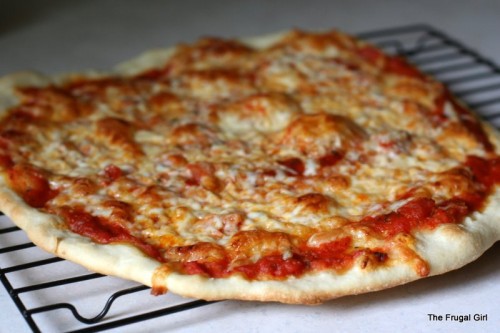
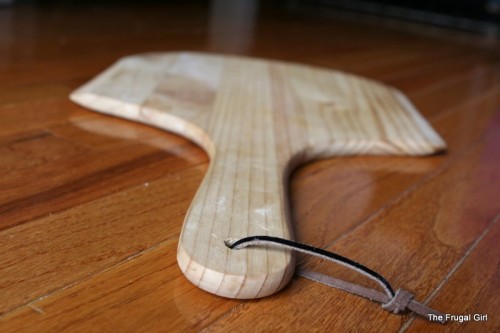
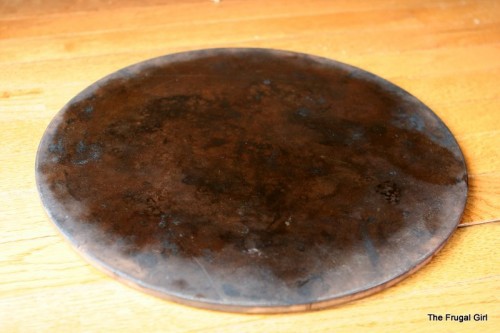
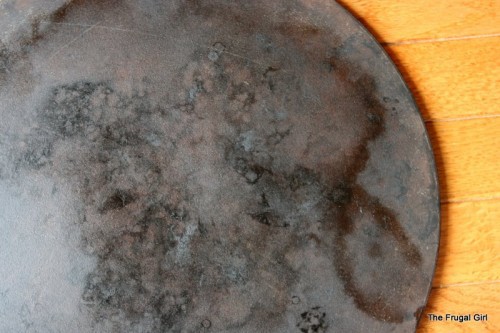
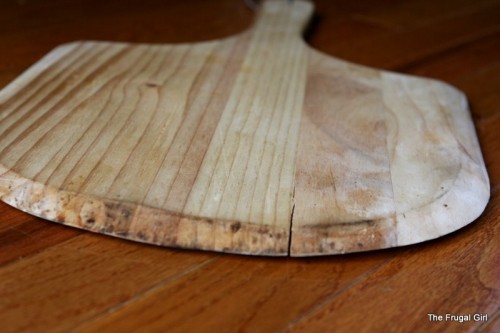
Homemade Pizza…again – IGOROTAK
Monday 31st of August 2009
[...] should mention that last weekend, after reading Kristen @ The Frugal Girl’s blog on musts for pizza baking, I was convinced to invest in a pizza stone and peel. See, I just started this love affair with [...]
Anki
Sunday 23rd of August 2009
No pizzastone and no peel in this house. We usually make tortilla pizza or place the dough directly on a baking mat and then bake the pizza on a pre-heated cookie sheet.
Becky
Friday 21st of August 2009
I just have large pizza forms with the holes in the bottom from Walmart. I have never seen pizza stones for sale here (Poland) and they are incredibly heavy to try to bring overseas in a suitcase. I make the dough, then put it on the pregreased and sprinkled with corn meal pizza forms. I let it sit for a minute or two while I clean up the counters in the kitchen and then finish making the pizzas.
I bake them in a convection oven. It works for me. Those stones look like they make much smaller pizzas than my family is used to.
calimama @ compactbydesign.com
Thursday 20th of August 2009
Kristen, so funny you should post this! Every time I make pizza I wonder what a stone that has been used excessively looks like! Mine is nowhere near yours but it's on it's way.
I have been thinking about trying my baking sheet in lieu of a pizza pan or screen as sometimes the crust is quite hard than I like and I think it is due to the stone. Any thoughts on getting a softer crust using a stone?
hiptobeme
Thursday 20th of August 2009
Now I want pizza :D